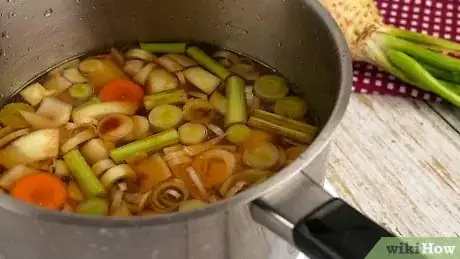wikiHow is a “wiki,” similar to Wikipedia, which means that many of our articles are co-written by multiple authors. To create this article, 15 people, some anonymous, worked to edit and improve it over time.
The wikiHow Culinary Team also followed the article's instructions and verified that they work.
This article has been viewed 70,494 times.
Learn more...
Stocks are one of the foundation ingredients of many dishes and it's important to know how to make each one and to make each one well. They are often very cheap to make and lift the flavour of a lot of foods, but the added beauty is that it is more economical -- they may be frozen for future needs so you will always have some to hand. When you take into account the cost and taste of mass produced stocks sold in tetra-packs or cubes, homemade stocks stand out superior in both counts.
Ingredients
- For chicken stock: 350g raw chicken carcass weighing or 250g chicken pieces on the bone such as wings, neck, (etc), 1 brown onion, 1 celery stem (without leaves), 1 small carrot. 1 x Bouquet garni.
- For beef stock: 1kg of beef bones and about 250g beef meat trimmings such as neck or shin (not offal or mince-meat however), or any cheap cut of beef with the bone. Any trace of meat will add to the flavour. 1 onion, 1 celery stem (without leaves), 1 small carrot. 1 x Bouquet garni.
- For vegetable stock: 1 onion, 1 celery stem (without leaves), 1 small carrot, 1 leek (white portion only). 1 x Bouquet garni. Other low starch vegetables are also recommended for extra flavour.
- For fish stock: 1 fish skeleton (such as cod or flounder, shrimp or lobster tails and shells) with head, spine and tail. 1 onion, 1 celery stem (without leaves)1 leek sliced (white part only). 1 x Bouquet garni.
- Bones and suitable cuts of meat can be sourced very cheaply from butchers or fishmongers - they are often thrown away so in some cases you may need to ask them in advance to keep some for you in their fridges.
- To make a richer or stronger stock, increase the proportions of bones, meat trimmings and vegetables (to suit relative recipes) by about 10% to the water added.
- Brown onion skins or beetroot skins are good natural dyes that can add colour to your stock
- Shellfish stock can be made in the same manner as fish stock, using discarded shrimp shells, crab shells, clam shells, or any other shellfish. Great as a base for chowder, bisque, seafood gumbo or Jambalaya.
Steps
-
1For chicken stock, heat a little oil or butter over medium heat and add the carcass. Brown the carcass all over while breaking it up with a wooden spoon. The browner you cook it, the browner the stock. Alternatively roast the carcass or chicken pieces until richly golden brown and add to the stock pot.
- Note: The leftover roast carcass removed of most meat is good to make a basic stock if you are economically minded and intend to make a chicken soup for the next day, as you can add the leftover roast meat to the soup at the last minute.
- This is not ideal for making basic stock as you would have to be very mindful of other flavours added to the chicken before roasting (such as sage and onion, garlic, lemon, spices etc) that will come through into the stock that may be undesirable in other dishes.
-
2Add the vegetables and bouquet garni and add water to the pan until the ingredients are covered (approx 4 cups or 1 litre of water). Simmer very gently for 30 minutes to 1 hour, although if you desire a nice clear stock it is best to cook at a lower 80-85C / 175-185F. A pressure cooker is a very useful way to make stocks quickly when you don't need the stock to be clear. A slow cooker can also work quietly in the background while you do other jobs. Other additions may be 100 milliliters (3.4 fl oz) of white wine, 3 small mushrooms (halved) or 1 tomato, in quarters.Advertisement
-
3Strain the stock through a fine sieve or cheesecloth and it is ready for use. It can be stored in the fridge in a large jar with lid, or frozen in snap lock bags or in containers for easy portion use. Alternatively, strain and allow it to sediment to collect the clear stock for Consommé soups. (see tips)
-
4For a rich brown beef stock, mix the bones and meat with a little melted butter in a roasting pan. Transfer the pan into a preheated moderate oven and roast until well browned.
-
5Tip the bones and meat trimmings into a stock pot and deglaze the roasting pan with a cup of water. Scrape the roasting pan clean with a wooden spoon to incorporate all the extra flavour into the water and pour this into the stock pot, add another 3 cups of water to the roasting pan to ensure all flavour and juices are collected and add this to the stockpot.
-
6Add the vegetables and bouquet garni and simmer very gently for 30 minutes to 1 hour, then strain and use as required. To make a make a sauce stock, boil the stock until reduced to 1/3 of its volume and use to enrich gravies and other sauces. To make a sauce base, boil to reduce to 1/4 volume to a rich syrup and add other flavourings to taste such as sautéed mushrooms or red shallots, mustard, red wine, crushed peppercorns or sautéed ginger or garlic.
-
7For light beef stock, follow the same procedure as for brown beef stock. However, for light beef stock, you don't need to roast the portions but add them raw to the pan with cold water and vegetables.
- Light beef stock has a very delicate flavour so is good for light soups.
-
8For vegetable stock, add a little oil into the stock pot and sauté the vegetables gently for a light stock. Alternately, cut the vegetables into large chunks and roast until golden. Add the water to cover and bouquet garni and simmer gently for 30 minutes.
- Other additions like chicken stock may be 100 milliliters (3.4 fl oz) of white wine, 3 small mushrooms (halved) or 1 tomato, in quarters.
-
9In a stock pan, add a little oil and add the fish scraps. Cook over low heat and add water, vegetables and bouquet. Simmer very gently no more than 20 minutes.
- 50mls of white wine may be added to fish stocks. This stock needs minimal cooking as prolonged cooking will make the stock turn grey and bitter.
Community Q&A
-
QuestionHow can I reconstitute stock and sauce?
 Community Answerif the stock/sauce is thin, you could add a couple tablespoons of flour to thicken. If it is thick, you can add water to make it thinner.
Community Answerif the stock/sauce is thin, you could add a couple tablespoons of flour to thicken. If it is thick, you can add water to make it thinner.
Things You'll Need
- Stock Pan, or any large saucepan with a lid.
- Wooden spoon
- Roasting pan (for brown beef stock)
- Chopping board & knife.
- Sieve

















































